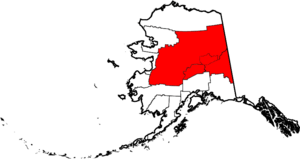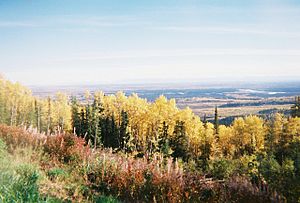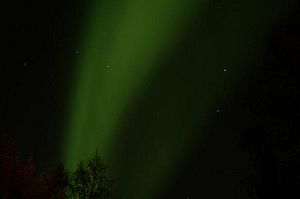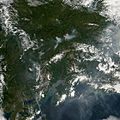Interior Alaska facts for kids
Interior Alaska is a huge central part of Alaska. It's mostly wild land, stretching from the Alaska Range in the south to the Brooks Range in the north. This region is home to some amazing mountains, like Denali, which is the tallest peak in North America!
The original people of Interior Alaska are mostly Alaskan Athabaskans. The biggest city here is Fairbanks, which is Alaska's second-largest city. Other towns you might find are North Pole, Eagle, and Delta Junction. About 113,154 people live in this vast area.
Contents
Climate in Interior Alaska
Interior Alaska has very wild weather! Temperatures change a lot between summer and winter. In Fairbanks, winter temperatures usually average around -12°F (-24°C). But it can get much colder, sometimes as low as -65°F (-54°C)!
Summers are much warmer, averaging about +62°F (+17°C). It can even reach +99°F (+37°C) in summer. The highest temperature ever recorded in Alaska was 100°F (38°C) in Fort Yukon, which is in the Interior. The lowest was -80°F (-62°C) in Prospect Creek.
Sometimes, very cold winter days can suddenly get warmer. This happens because of a special wind called a chinook wind.
Wildfires and Precipitation
Summers can be warm and dry for a long time. This creates perfect conditions for wildfires. Lightning from thunderstorms often starts these fires. Many fires are far from towns, so they are often allowed to burn out naturally. In 2004, a record 6.6 million acres (26,700 square kilometers) burned in Alaska.
Fairbanks gets about 11.3 inches (287 mm) of rain and snow each year. Most of this falls as snow in winter. Many storms come from the Gulf of Alaska to the south. However, the Alaska Range mountains block some of the moisture, creating a "rain shadow" effect.
Daylight and Permafrost
On clear winter nights, you can often see the amazing aurora borealis, also known as the Northern Lights! In summer, from May to July, the sun barely sets. It stays light almost all night.
But in winter, from November to January, there is very little daylight. Fairbanks gets only about four hours of daylight each day during this time.
Much of Interior Alaska has permafrost underground. This means the ground stays frozen all year round. The closer you get to the Arctic Circle, the more continuous the permafrost becomes.
- Summer 2009 Fires (outlined in red)
Native People of Interior Alaska
Most of the Native people living in Interior Alaska are Athabaskan. However, there are also many Yup'ik and Iñupiaq people in Fairbanks.
Many Native communities in Interior Alaska are officially recognized by the government. These are called federally recognized tribes. They include:
- Council of Athabascan Tribal Governments (CATG): This group includes villages like Beaver Village, Birch Creek Tribe, and Native Village of Fort Yukon.
- Tanana Chiefs Conference (TCC): This is a larger group with many villages, such as Allakaket Village, Native Village of Eagle, Galena Village, and Nenana Native Association.
- Tanana Tribal Council: This council represents the Native Village of Tanana.
There are also other places in the Interior that are not federally recognized as tribes. These include towns like Anderson, Delta Junction, and North Pole.








